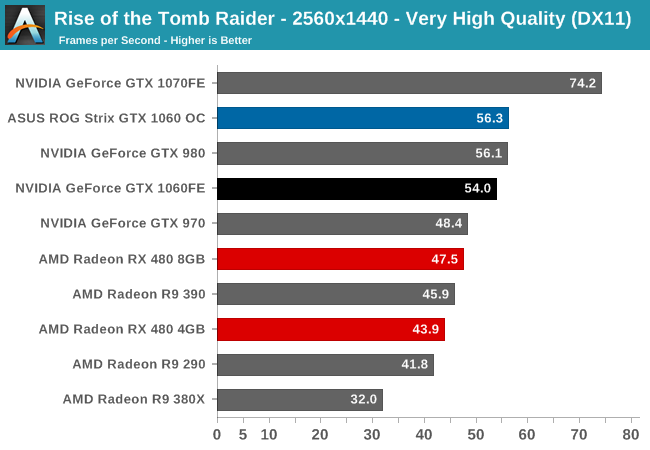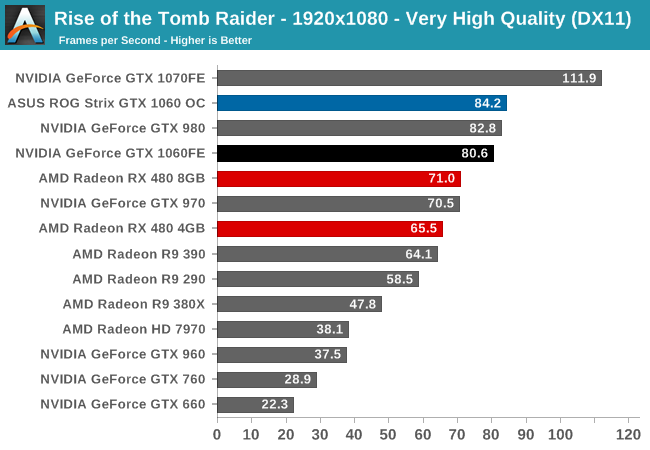The GeForce GTX 1060 Founders Edition & ASUS Strix GTX 1060 Review
by Ryan Smith on August 5, 2016 2:00 PM ESTRise of the Tomb Raider
Starting things off in our benchmark suite is the built-in benchmark for Rise of the Tomb Raider, the latest iteration in the long-running action-adventure gaming series. One of the unique aspects of this benchmark is that it’s actually the average of 4 sub-benchmarks that fly through different environments, which keeps the benchmark from being too weighted towards a GPU’s performance characteristics under any one scene.


NVIDIA promised GTX 980-like performance for the GTX 1060, and this is more or less where they’ve landed under Tomb Raider. The otherwise stock clocked GTX 1060FE underperforms GTX 980 by only a frame or two, delivering about 97% of the performance, while the factory overclocked ASUS card makes up the difference and takes the lead. Or to compare things to the next tier up, GTX 1060 is delivering about 72% of GTX 1070’s performance for about 65% of the price.
Meanwhile the performance gains over the past generation GTX x60 cards are remarkable. Whereas GTX 960 struggled to break out of the 30s on framerate, GTX 1060 just cracks 80fps. This is 215% of GTX 960’s performance, more than doubling its predecessor. Some of this I don’t doubt comes down to memory – our GTX 960 is the more common 2GB variety – but it also goes to show once again how 2GB cards are now VRAM limited under modern games. And the performance gains are even greater if we go back to 2013’s GTX 760 or 2012’s GTX 660. GTX 960’s one disappointment was that it didn’t make as much progress over GTX 760 as everyone would like, but GTX 1060 more than makes up for this.
As for the AMD competition, things shape up about as you’d expect. In our look at RX 480 we found that it delivered GTX 970-like performance, while GTX 1060 is slated to deliver GTX 980-like performance. As a result we see the GTX 1060 lead by around 15% at both resolutions for Tomb Raider.










189 Comments
View All Comments
Notmyusualid - Sunday, August 7, 2016 - link
Seems amazingly mis-priced.The lowest I see a GTX1060 for, on Amazon.co.uk is 260 GBP (delivered). That is $340 USD.
The pound didn't fall that much.
silverblue - Monday, August 8, 2016 - link
True, but what taxes go on top of that $250? As a Brit myself, that's out of genuine curiosity.thesavvymage - Monday, August 8, 2016 - link
Taxes vary by location, in my state, Washington, sales tax is almost 10% (which i think might be the highest sales tax) so it'd land around 275. UK prices include taxes, US dont, so the price premium isnt as much as you'd initially thinkmdw9604 - Sunday, August 7, 2016 - link
Why aren't the 1080 performance numbers included in the Charts? This thing cost about half as much, would expect about half the performance. But b/c they were not included, can't cant really come to that conclusion.Ryan Smith - Monday, August 8, 2016 - link
While the charts can handle more results, we're trying to keep things readable. If you want a 1080 comparison, Bench would be perfect for this.mdw9604 - Monday, August 8, 2016 - link
Thanks for taking the time to reply, will check it out. Would think it would be useful to include the newest high-end nvida graphics cards for perspective.medi03 - Monday, August 8, 2016 - link
Thanks for the review, Ryan.I've noticed difference in power consumption results between your and other sites (let's take TPU for example).
You are testing total power consumption, which, given PSU's 80%-ish efficiency, should give bigger differences between cards, than if testing power consumption of GPU alone (pcie/connectors).
On your site, ref 480 consumes 37 watt more than 1060.
Ref 1070 consumes 6 watt more than 480.
On TPU site (PCIe, "average gaming"):
1) 480 consumes 47 watt more, which, taking 80% PSU efficiency in account, is 58.7 watt more
2) 1070 consumes a bit less than 480
(review is for an AIB, but I'm comparing Ref vs FE numbers)
https://www.techpowerup.com/reviews/Palit/GeForce_...
Any thought about why that might be? Can chips really vary that much? Is power consumption that different between different games?
Ryan Smith - Monday, August 8, 2016 - link
"Can chips really vary that much?"Yes, especially since these cards are at times TDP limited .Move the temperature up or down by 5F and you'll get slightly different results with blowers, for example. That said...
"Is power consumption that different between different games?"
Absolutely. There can be a massive difference in the CPU load from the simulation, and on the GPU side there's the balance between texturing/shading/ROPing. We can't test all games, so with Crysis 3 we try to pick a game that offers a reasonable middle case. But if someone else uses a different game they can get very different results.
Greeba77 - Monday, August 8, 2016 - link
Great review as always, however I was hoping this would also take in the recent benchmarks that have come out comparing the 1060 to the RX480 using Vulkan on Doom, in which I gather the Nvida card completely tanked. And of course whether this should have any bearing on any decision to buy anyway... if the regular performance is as clear cut as it looks then it seems the 1060 is a pretty good mid range upgrade choice for me (I have an R9 270X at the moment so it's a few generations old and this or an RX480 will smash it.)beck2050 - Monday, August 8, 2016 - link
Great card for the money when prices settle down. Early adopters always pay more for popular tech.